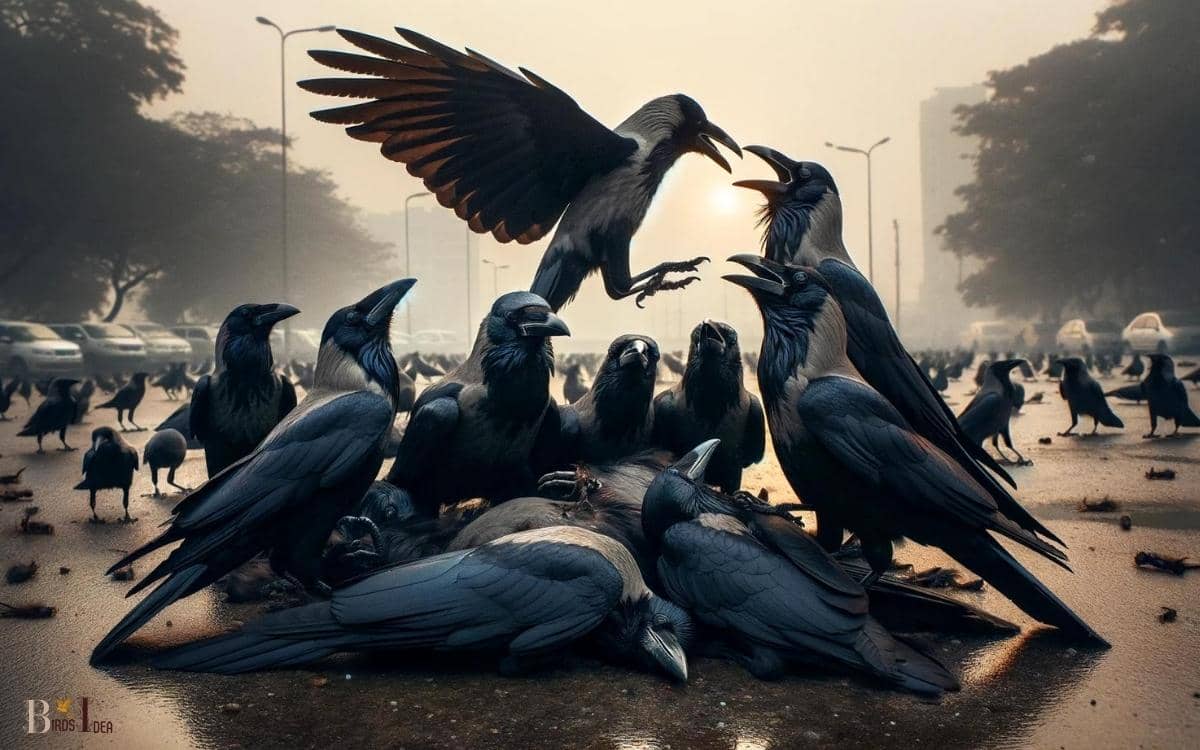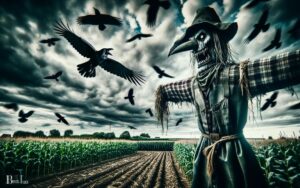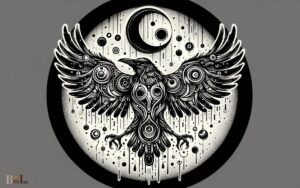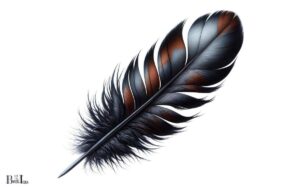What Do Crows Do When One Dies? Discover The Behavior!
Crows exhibit a complex behavior known as a ‘crow funeral’ when they encounter a dead member of their species.
These intelligent birds gather around the deceased, cawing and calling out, which is believed to be a form of social learning about potential dangers. Crows are highly social and intelligent birds that display a particular interest in their dead.
The behavior includes:
- Gathering around the body in large numbers
- Calling out loudly, which may alert other crows to the presence of a potential threat
- Occasionally touching the body or poking it with their beaks
Scientists believe these actions serve several purposes:
- Assessing the cause of death to learn about potential threats in the area
- Reinforcing social bonds among the surviving crows
- Teaching younger crows about dangers
Crows’ reactions to death, often referred to as ‘crow funerals,’ are not only a testament to their intelligence but also a window into how they perceive and process mortality within their communities.

Key Takeaway
The Response to Death
One significant behavior observed in crows is their communal response to the death of a fellow crow.
When a crow dies, others from the same community gather around, exhibiting behaviors that suggest they are mourning the loss.
They may call out, gather in large numbers, or even perform aerial displays as a sign of respect.
This communal response to death indicates a level of emotional intelligence and social complexity that is not commonly associated with birds.
The fact that crows exhibit such behavior highlights their advanced social dynamics and suggests that they may have a deeper understanding of mortality and loss than previously thought.
This response to death is just one example of the fascinating behaviors that crows display, showcasing their complex and intricate social structures.
Gathering in groups, crows demonstrate a unique ability to communicate and connect with one another, which is further evident in their responses to death.
Gathering in Groups
The communal response to death observed in crows is closely tied to their tendency to gather in groups, reflecting their advanced social dynamics and intricate communication skills.
When a crow dies, other crows often gather in what appears to be a communal response. This behavior suggests that crows not only recognize death but also have an organized way of dealing with it.
The act of gathering in groups may serve various purposes, such as sharing information about potential threats, finding mates, or even grieving the loss of a group member.
This group behavior also allows for the exchange of knowledge and experiences, contributing to the overall survival and success of the crow community.
Understanding the significance of gathering in groups provides valuable insights into the complex social structure and behaviors of crows.
Vocalizing Distress
When a crow dies, its fellow crows vocalize loudly, emitting distinct distress calls that are recognizable to other crows.
This vocalization is a clear indicator of their distress and mourning, often drawing the attention of other crows in the area.
Through these calls, crows communicate their sorrow and potentially warn others of potential threats or dangers in the vicinity.
Crows Vocalize Loudly
Crows vocalize loudly as a means of expressing distress when one of their own dies. This vocalization serves as a way for the remaining crows to communicate their grief and possibly warn other crows in the area of potential danger.
The loud and raucous calls are a form of catharsis for the crows, allowing them to release their emotions and process the loss within their social group.
The table below illustrates some common vocalizations of crows and their potential meanings:
| Vocalization | Meaning |
|---|---|
| Caw | Territory defense or communication |
| Rattle | Alarm or warning |
| Coarse cawing | Agitation or distress |
| Clicking | Sign of aggression or annoyance |
| High-pitched caw | Excitement or agitation |
Understanding these vocalizations can provide insight into the emotional lives of these intelligent and social birds.
Distinct Distress Calls
Vocalizing distress, crows emit distinct calls to express their grief and signal potential danger to their fellow group members.
These calls are characterized by a harsh, guttural tone that is noticeably different from their usual cawing.
The distress calls serve as a means of communication, alerting other crows to the presence of a potential threat or the loss of a group member.
The distinct vocalizations also convey the emotional state of the crows, indicating their heightened agitation or sorrow.
This unique form of communication among crows demonstrates their complex social dynamics and their ability to convey and respond to emotional distress within their community.
Understanding these distinct distress calls sheds light on the depth of their social interactions and the significance of vocalization in expressing grief and signaling danger.
Investigating the Deceased
Upon discovering a deceased crow, other members of the group will immediately gather around the body to investigate.
This behavior is driven by the crow’s innate curiosity and intelligence. Crows are known for their advanced problem-solving skills and high level of social awareness.
When a crow dies, other members of the group engage in a thorough examination of the body. They may peck at the body, caw loudly, or even pull at the feathers.
This investigation serves multiple purposes, including determining the cause of death, assessing potential threats in the environment, and learning from the experience.
It also allows the group to collectively process the loss and potentially adapt their behaviors to avoid similar dangers in the future.
This investigative process showcases the complex social dynamics and cognitive abilities of crows.
Mourning Rituals
As we explore the behaviors of crows when faced with the loss of one of their own, it is crucial to delve into the concept of mourning rituals.
Understanding the mourning behaviors of crows and the social significance of such rituals can provide insight into the complex nature of avian social dynamics.
Crow Mourning Behaviors
After the death of a crow, other crows often gather around and engage in mourning behaviors, exhibiting signs of grief and respect for the deceased.
This behavior has been observed and studied by scientists, shedding light on the emotional intelligence and social complexity of these highly intelligent birds.
Crow mourning behaviors include:
- Gathering: Crows will gather around the deceased bird, often remaining in close proximity for extended periods.
- Vocalizations: The crows may engage in a chorus of cawing and calling, creating a somber and eerie atmosphere.
- Physical Gestures: Crows have been observed touching the deceased bird with their beaks, as if to express tenderness or to understand the nature of death.
These behaviors demonstrate the deep emotional connections and social bonds within crow communities, evoking a sense of empathy and understanding in observers.
Social Significance of Mourning
The demonstration of mourning behaviors by crows following the death of a fellow member underscores the social significance of mourning rituals within their communities.
Crows have been observed gathering around deceased members, vocalizing in a distinct manner, and displaying behaviors that indicate distress and a sense of loss.
These mourning rituals serve as a means for crows to acknowledge the passing of a member and potentially communicate the event to other members of their community.
Such behaviors highlight the depth of social connections and emotional intelligence within crow societies, challenging previous assumptions about the emotional lives of non-human animals.
Understanding the social significance of mourning rituals in crows sheds light on the complex and interconnected nature of their communities, offering valuable insights into their social dynamics and relationships.
Cognitive Abilities
Crows’ cognitive abilities are integral to their complex social dynamics, allowing them to navigate intricate family structures and communicate effectively within their communal roosting environments.
These highly intelligent birds possess remarkable problem-solving skills, demonstrate advanced reasoning, and exhibit a capacity for complex communication.
Studies have shown that crows are capable of recognizing human faces, using tools, and even understanding analogies.
Their ability to remember feeding sites and to plan for the future showcases their impressive cognitive prowess.
Furthermore, crows have been observed engaging in play behavior, which indicates a level of cognitive sophistication often associated with higher-order mammals.
Their cognitive abilities enable them to adapt to a variety of environments and challenges, contributing to their success as a species and their intriguing social behaviors.
Conclusion
The behavior of crows in response to death is complex and demonstrates their social and cognitive capabilities.
Their gathering in groups, vocalizing distress, investigating the deceased, and engaging in mourning rituals reflect their deep understanding of mortality and the importance of social bonds.
The idiom ‘actions speak louder than words’ aptly captures the profound and expressive nature of crows’ response to death, highlighting the depth of their social and emotional intelligence.






